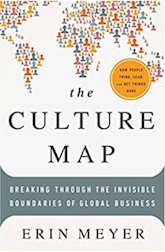|
International Business expert Erin Meyers shares her important theorizations of cultural difference, and personal anecdotes - some hilarious, others depressing - about cultural differences in her outstanding 2014 book The Culture Map: Breaking through the Invisible Boundaries of Global Business.
 Using eight scales, she locates many of the world’s cultures on a continuum. For example, on the scale of measuring perceptions of time, American culture is located more towards the linear-time pole, farther away from the flexible-time pole, where Indonesian culture is situated, for example. Using eight scales, she locates many of the world’s cultures on a continuum. For example, on the scale of measuring perceptions of time, American culture is located more towards the linear-time pole, farther away from the flexible-time pole, where Indonesian culture is situated, for example.
The eight scales are:
(issue/ topic [one pole vs. opposite pole])
- Communicating - low vs. high context
- Evaluating - direct vs. indirect negative feedback
- Persuading - principles vs. applications-first
- Leading - egalitarian vs. hierarchical
- Deciding - consensual vs. top-down
- Trusting - task vs. relationship-based
- Disagreeing - confrontational vs. avoids confrontation
- Scheduling - linear vs. flexible-time
To overview each scale, (and doing an injustice to each chapter’s content), all cultures can be evaluated by:
- how directly their words communicate the intended message;
- how directly/publicly negative feedback is usually given/ received;
- whether people are most persuaded by theoretical ideas or practical examples;
- who leads efforts: a group(s) or an individual(s);
- who makes decisions, and how/ with how much input from subordinates;
- how trust is usually developed: through efficient job performance or through amical, longitudinal relationships
- the level of directness with which one should disagree, and with whom; and
- the way time is treated: with precision or with laxity.
ITA educators should find ways to incorporate insights into their courses, preparing ITA’s for successful navigation of the American undergraduate classroom and academic culture. Moreover, these skills will also serve them in their post-graduation lives.
Possible class activities would be to plot where ITA’s believe American culture falls on these scales, and to compare them to where Erin Meyer positions American culture.
Similarly, and possibly more importantly, ITA’s should know where their own cultures fall on these scales. They could repeat the activity with guesses of their own culture, then compare them to Meyers’ findings.
Some ITA’s or even ITA educators may argue that people’s individual personalities are what counts, and it is problematic to stereotype cultures with such broad brushes. Yes, individuals have unique personalities, however, “If you go into every interaction assuming that culture doesn’t matter, your default mechanism will be to view others through your own cultural lens and to judge or misjudge them” (p. 13).
Whether used in ITA training classes or not, this book will surely not disappoint ITA educators, a highly-educated, globally-curious crew if there ever was one.
Roger Anderson is an assistant professor of international languages and cultures (French/ Arabic) at Central State University, Ohio’s only public, historically-black college/ university (BHCU). No longer directly involved with ITA education, he is thankful for the tremendous contributions of his international students to his domestic students’ learning, and to his own. |

